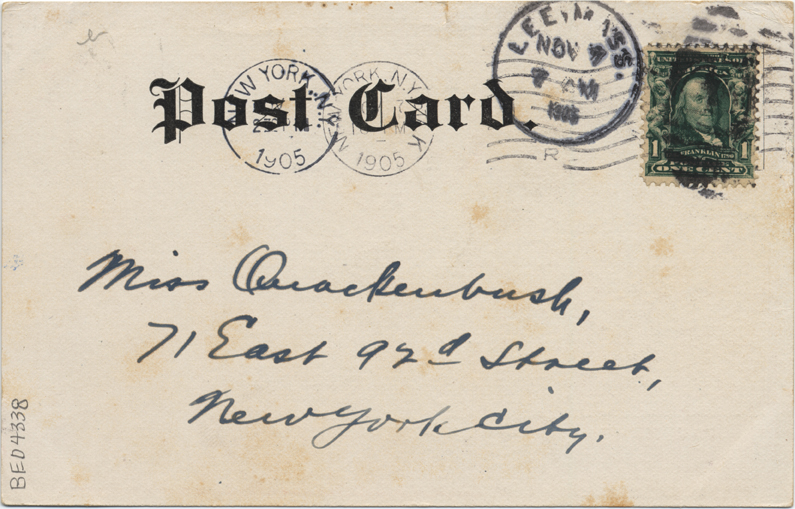Deltiology is the formal name for postcard collecting, and remains the third largest collectable hobby in the world. It is surpassed only by coin and stamp collecting.
The tradition of sending postcards did not appear out of thin air. The global postal system made a number of innovations during the 1800s that helped create this new postal age. One such innovation was the introduction of uniform penny postage stamps in Great Britain in 1840 that made mail delivery easy and affordable. The postage stamp quickly gained popularity. Prior to that prices for shipping letters was based on the distance the mailman had to travel.
The direct ancestor of postcards is envelopes printed with pictures on them. These first decorative envelopes are believe to be first produced by D. William Mulready, E.R.W. Hume, Dickey Doyle, and James Valentine. The envelopes were often printed with pictures of comics, Valentines, musical notes and patriotic pictures (Patriotic Covers) during the Civil War period of 1861-1865.
Austria became the first country to publish the postcard, but not the first to conceive of the idea. A few years earlier, German postal official Dr. Heinrich von Stephan submitted a proposal for such an object, which was then fiercely debated and not executed in North Germany until July 1870, a year after Austria introduced the postcard to their country. Within two years, variations of the postcard had quickly spread across Europe. Canada introduced the postcard in 1871 and the United States introduced officially issued postcards in 1873. In 1875, delegates of 22 countries met in Switzerland as the General Postal Union and established a standard postage rate and government issued card to be exchanged between countries in the union; four years later they renamed themselves the Universal Postal Union.
The first postal card was suggested by Dr. Emanuel Herrmann, in 1869, and was accepted by the Austrian-Hungarian government in the same year. The first regularly printed card appeared in 1870, a historical card, produced in connection with the Franco-German War. The first advertising card appeared in 1872 in Great Britain. Cards showing the Eiffel Tower appeared in 1889. A Heligoland card of 1889 is considered to be the first multi-coloured card ever printed.
Private Mailing Card Era, 1898-1901
Starting in 1898, American publishers were expanding postcard printing services and were allowed to print and sell postcards bearing the inscription, "Private Mailing Card, Authorized by Act of Congress on May 19, 1898". These private mailing cards were to be posted with one cent stamps (the same rate as USA government postcards). This was perhaps the most significant event in the USA to enhance the use of private postals.
Example of a court card, postmarked 1899, showing Robert Burns and his cottage and monument in Ayr
The Golden Age, 1901-1907
In 1901, the U.S. Government granted the use of the words "Post Card" to be printed on the undivided back of privately printed cards and allowed publishers to drop the authorization inscription previously required since 1898. As in earlier eras, writing was still limited to one side of the card, but now other countries began to permit the use of a divided writing side so that the left side was for writing messages and the right side for the address. England was the first country to permit the divided back in 1902, France followed in 1904, Germany in 1905 and finally the USA in 1907. These changes plus increased literacy ushered in the "Golden Age" of postcards as millions were sold and used.
Back of the above 1905 card
Divided Back Era, 1907-1915
By this period, a divided section for writing was almost universal, except in a few monopolistic governments. Prior to and during this period, a majority of American postcards were actually printed in Europe, especially in Germany whose printing methods were regarded as the best in the world. However the economics of this era, the rising import tariffs and the outbreak of war (World War I started in 1914) led to a swift decline in the cards imported to North America. Thus the political strains of the day brought about the end of the "Golden Age" as publishers in North America began to claim a larger part of the pie.
Postcard with 1908 cancellation
Early Modern Era (White Border), 1916-1930
During this period, American technology advanced allowing them to produce higher quality cards, although often publishers produced cheaper inferior ones in order to compete in the saturated market place. Public appeal changed and greeting card publications declined. However the view card market remained strong. The cards of this era were usually printed with white borders around the picture, thus the term "White Border Cards".
American 'divided back' postcard, 1916
Linen Card Era, 1930-1945
Changing technology now enabled publishers to print cards on a linen type paper stock with very bright and vivid colours. View and comic cards were the most often published. Sets and series were few and far between and the greeting card was almost exclusively replaced with the new French-fold cards. Among the best cards of this era are the political humor cards of World War II.
Modern Chrome Era, 1939-Present
The Union Oil Series began in 1939, launching the new era of photochrome cards. Photochromes are commonly called "Modern Chromes", are still the most popular cards today. Since the earlier days of fine printing craftsmanship, these are the best reproductions to come along in years and commonly sought by collectors. Despite the increase in postal rates for postcards from one cent to significantly higher prices, postcard popularity continues to rise. The old greeting postcard style is making a big return, though usually seen as reproductions of older cards, despite new original art is being produced.




No comments:
Post a Comment
Thanks U 4 comments ;)